Nutrition Case Study: Type 1 Diabetes and Ketoacidosis
VerifiedAdded on 2022/09/28
|17
|5079
|35
Case Study
AI Summary
This case study presents a 71-year-old female admitted to the Emergency Department with difficulty breathing and lethargy, diagnosed with Diabetic Ketoacidosis (DKA) associated with Type 1 Diabetes Mellitus, Sepsis, ESRD, and Pneumonia. The patient's extensive medical history includes CVA, seizure disorder, hyperlipidemia, HTN, ESRD on HD, asthma, atrial fibrillation, HCV, CAD, hypothyroidism, neuropathy, depression, and glaucoma. Pertinent lab data reveals critical abnormalities in albumin, total protein, calcium, HbA1c, sodium, BUN, creatinine, glucose, HGB, and HCT levels. Medical treatments include various medications for multiple conditions. The assignment requires calculating anthropometrics (BMI, IBW, %IBW, % weight change), formulating PES statements, recommending dietary interventions, and defining nutrition goals (short-term and long-term), alongside an explanation for the recommended diet. This case study emphasizes the complex interplay of diabetes, kidney disease, and nutritional management.
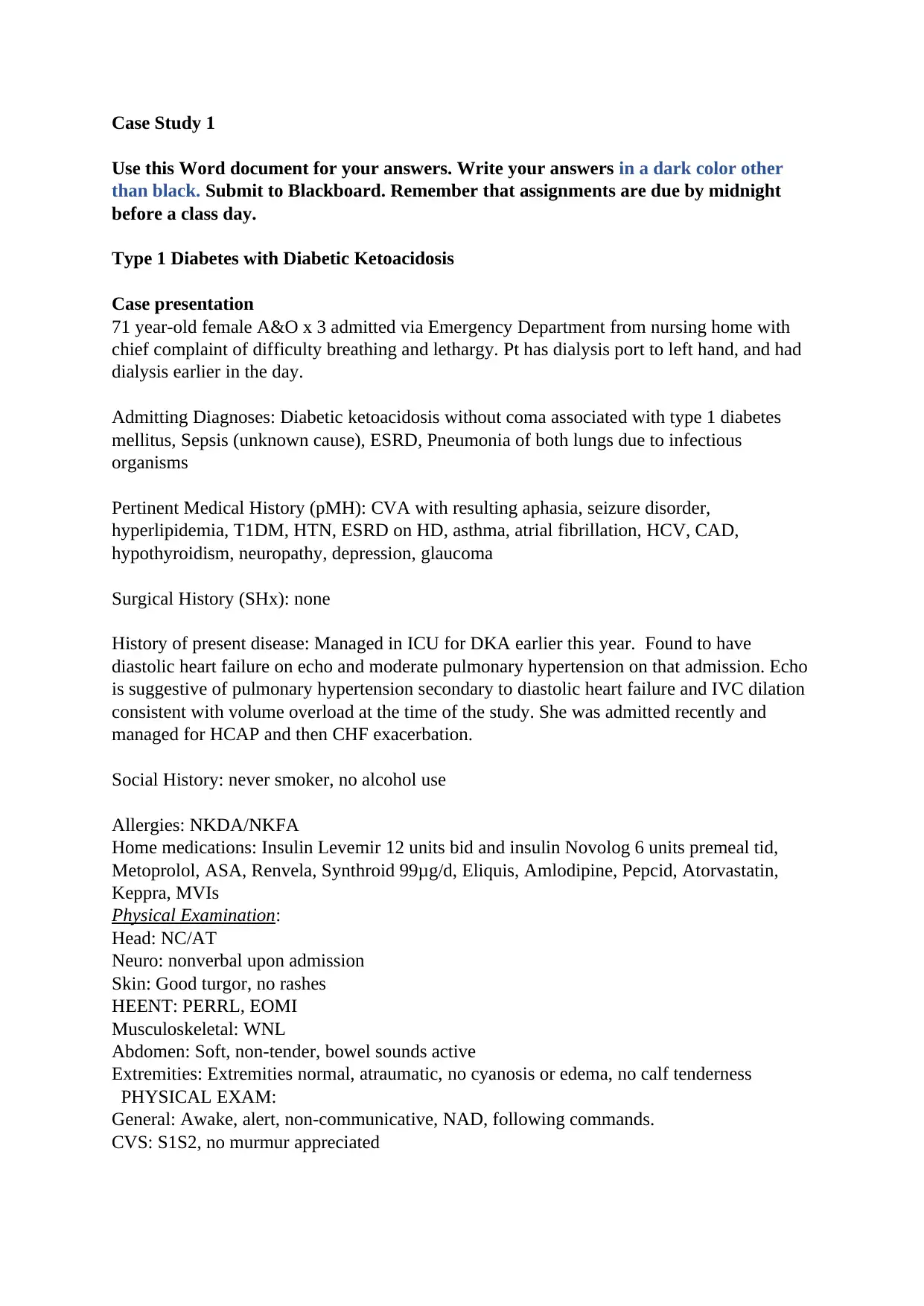
Case Study 1
Use this Word document for your answers. Write your answers in a dark color other
than black. Submit to Blackboard. Remember that assignments are due by midnight
before a class day.
Type 1 Diabetes with Diabetic Ketoacidosis
Case presentation
71 year-old female A&O x 3 admitted via Emergency Department from nursing home with
chief complaint of difficulty breathing and lethargy. Pt has dialysis port to left hand, and had
dialysis earlier in the day.
Admitting Diagnoses: Diabetic ketoacidosis without coma associated with type 1 diabetes
mellitus, Sepsis (unknown cause), ESRD, Pneumonia of both lungs due to infectious
organisms
Pertinent Medical History (pMH): CVA with resulting aphasia, seizure disorder,
hyperlipidemia, T1DM, HTN, ESRD on HD, asthma, atrial fibrillation, HCV, CAD,
hypothyroidism, neuropathy, depression, glaucoma
Surgical History (SHx): none
History of present disease: Managed in ICU for DKA earlier this year. Found to have
diastolic heart failure on echo and moderate pulmonary hypertension on that admission. Echo
is suggestive of pulmonary hypertension secondary to diastolic heart failure and IVC dilation
consistent with volume overload at the time of the study. She was admitted recently and
managed for HCAP and then CHF exacerbation.
Social History: never smoker, no alcohol use
Allergies: NKDA/NKFA
Home medications: Insulin Levemir 12 units bid and insulin Novolog 6 units premeal tid,
Metoprolol, ASA, Renvela, Synthroid 99μg/d, Eliquis, Amlodipine, Pepcid, Atorvastatin,
Keppra, MVIs
Physical Examination:
Head: NC/AT
Neuro: nonverbal upon admission
Skin: Good turgor, no rashes
HEENT: PERRL, EOMI
Musculoskeletal: WNL
Abdomen: Soft, non-tender, bowel sounds active
Extremities: Extremities normal, atraumatic, no cyanosis or edema, no calf tenderness
PHYSICAL EXAM:
General: Awake, alert, non-communicative, NAD, following commands.
CVS: S1S2, no murmur appreciated
Use this Word document for your answers. Write your answers in a dark color other
than black. Submit to Blackboard. Remember that assignments are due by midnight
before a class day.
Type 1 Diabetes with Diabetic Ketoacidosis
Case presentation
71 year-old female A&O x 3 admitted via Emergency Department from nursing home with
chief complaint of difficulty breathing and lethargy. Pt has dialysis port to left hand, and had
dialysis earlier in the day.
Admitting Diagnoses: Diabetic ketoacidosis without coma associated with type 1 diabetes
mellitus, Sepsis (unknown cause), ESRD, Pneumonia of both lungs due to infectious
organisms
Pertinent Medical History (pMH): CVA with resulting aphasia, seizure disorder,
hyperlipidemia, T1DM, HTN, ESRD on HD, asthma, atrial fibrillation, HCV, CAD,
hypothyroidism, neuropathy, depression, glaucoma
Surgical History (SHx): none
History of present disease: Managed in ICU for DKA earlier this year. Found to have
diastolic heart failure on echo and moderate pulmonary hypertension on that admission. Echo
is suggestive of pulmonary hypertension secondary to diastolic heart failure and IVC dilation
consistent with volume overload at the time of the study. She was admitted recently and
managed for HCAP and then CHF exacerbation.
Social History: never smoker, no alcohol use
Allergies: NKDA/NKFA
Home medications: Insulin Levemir 12 units bid and insulin Novolog 6 units premeal tid,
Metoprolol, ASA, Renvela, Synthroid 99μg/d, Eliquis, Amlodipine, Pepcid, Atorvastatin,
Keppra, MVIs
Physical Examination:
Head: NC/AT
Neuro: nonverbal upon admission
Skin: Good turgor, no rashes
HEENT: PERRL, EOMI
Musculoskeletal: WNL
Abdomen: Soft, non-tender, bowel sounds active
Extremities: Extremities normal, atraumatic, no cyanosis or edema, no calf tenderness
PHYSICAL EXAM:
General: Awake, alert, non-communicative, NAD, following commands.
CVS: S1S2, no murmur appreciated
Paraphrase This Document
Need a fresh take? Get an instant paraphrase of this document with our AI Paraphraser
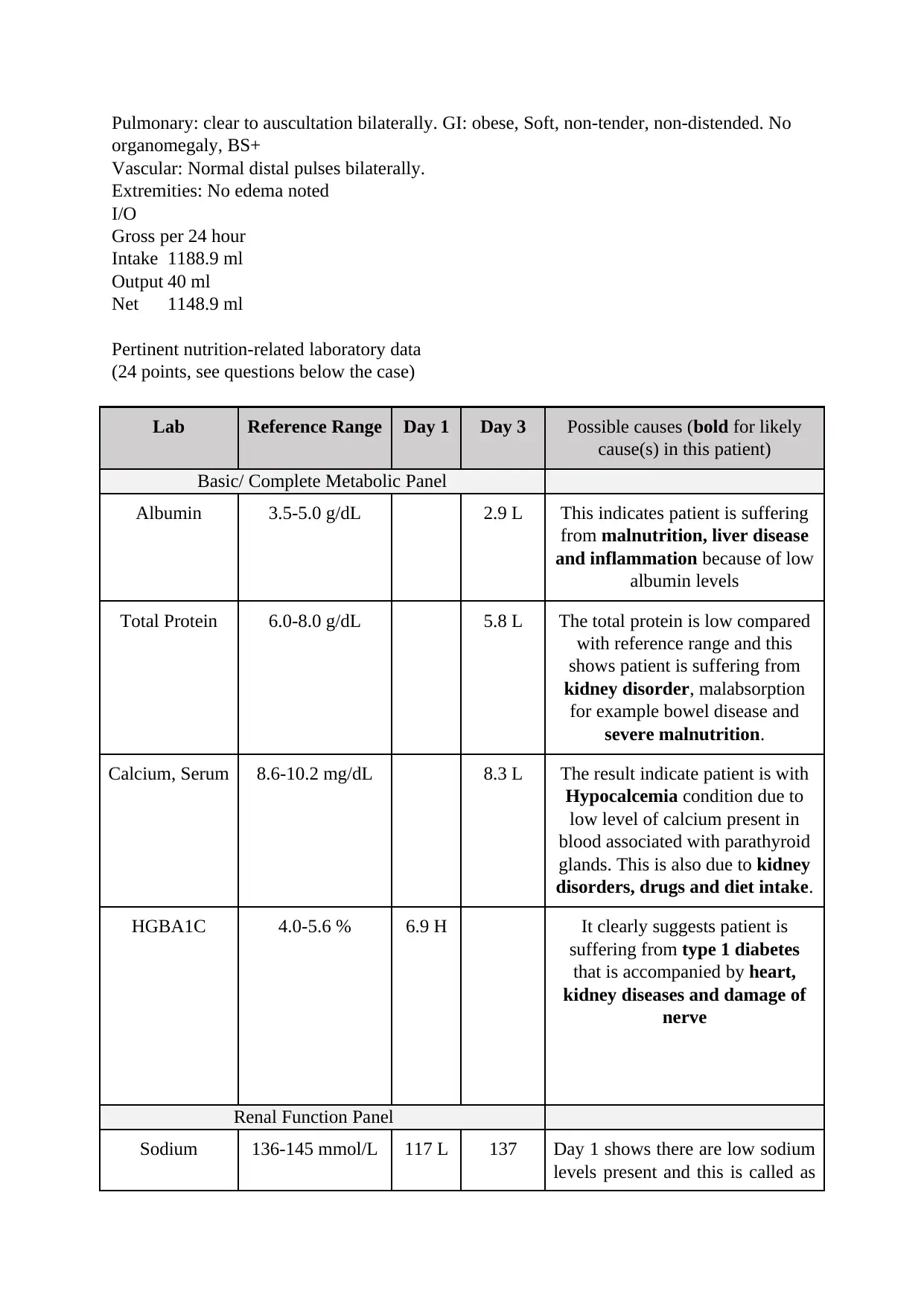
Pulmonary: clear to auscultation bilaterally. GI: obese, Soft, non-tender, non-distended. No
organomegaly, BS+
Vascular: Normal distal pulses bilaterally.
Extremities: No edema noted
I/O
Gross per 24 hour
Intake 1188.9 ml
Output 40 ml
Net 1148.9 ml
Pertinent nutrition-related laboratory data
(24 points, see questions below the case)
Lab Reference Range Day 1 Day 3 Possible causes (bold for likely
cause(s) in this patient)
Basic/ Complete Metabolic Panel
Albumin 3.5-5.0 g/dL 2.9 L This indicates patient is suffering
from malnutrition, liver disease
and inflammation because of low
albumin levels
Total Protein 6.0-8.0 g/dL 5.8 L The total protein is low compared
with reference range and this
shows patient is suffering from
kidney disorder, malabsorption
for example bowel disease and
severe malnutrition.
Calcium, Serum 8.6-10.2 mg/dL 8.3 L The result indicate patient is with
Hypocalcemia condition due to
low level of calcium present in
blood associated with parathyroid
glands. This is also due to kidney
disorders, drugs and diet intake.
HGBA1C 4.0-5.6 % 6.9 H It clearly suggests patient is
suffering from type 1 diabetes
that is accompanied by heart,
kidney diseases and damage of
nerve
Renal Function Panel
Sodium 136-145 mmol/L 117 L 137 Day 1 shows there are low sodium
levels present and this is called as
organomegaly, BS+
Vascular: Normal distal pulses bilaterally.
Extremities: No edema noted
I/O
Gross per 24 hour
Intake 1188.9 ml
Output 40 ml
Net 1148.9 ml
Pertinent nutrition-related laboratory data
(24 points, see questions below the case)
Lab Reference Range Day 1 Day 3 Possible causes (bold for likely
cause(s) in this patient)
Basic/ Complete Metabolic Panel
Albumin 3.5-5.0 g/dL 2.9 L This indicates patient is suffering
from malnutrition, liver disease
and inflammation because of low
albumin levels
Total Protein 6.0-8.0 g/dL 5.8 L The total protein is low compared
with reference range and this
shows patient is suffering from
kidney disorder, malabsorption
for example bowel disease and
severe malnutrition.
Calcium, Serum 8.6-10.2 mg/dL 8.3 L The result indicate patient is with
Hypocalcemia condition due to
low level of calcium present in
blood associated with parathyroid
glands. This is also due to kidney
disorders, drugs and diet intake.
HGBA1C 4.0-5.6 % 6.9 H It clearly suggests patient is
suffering from type 1 diabetes
that is accompanied by heart,
kidney diseases and damage of
nerve
Renal Function Panel
Sodium 136-145 mmol/L 117 L 137 Day 1 shows there are low sodium
levels present and this is called as
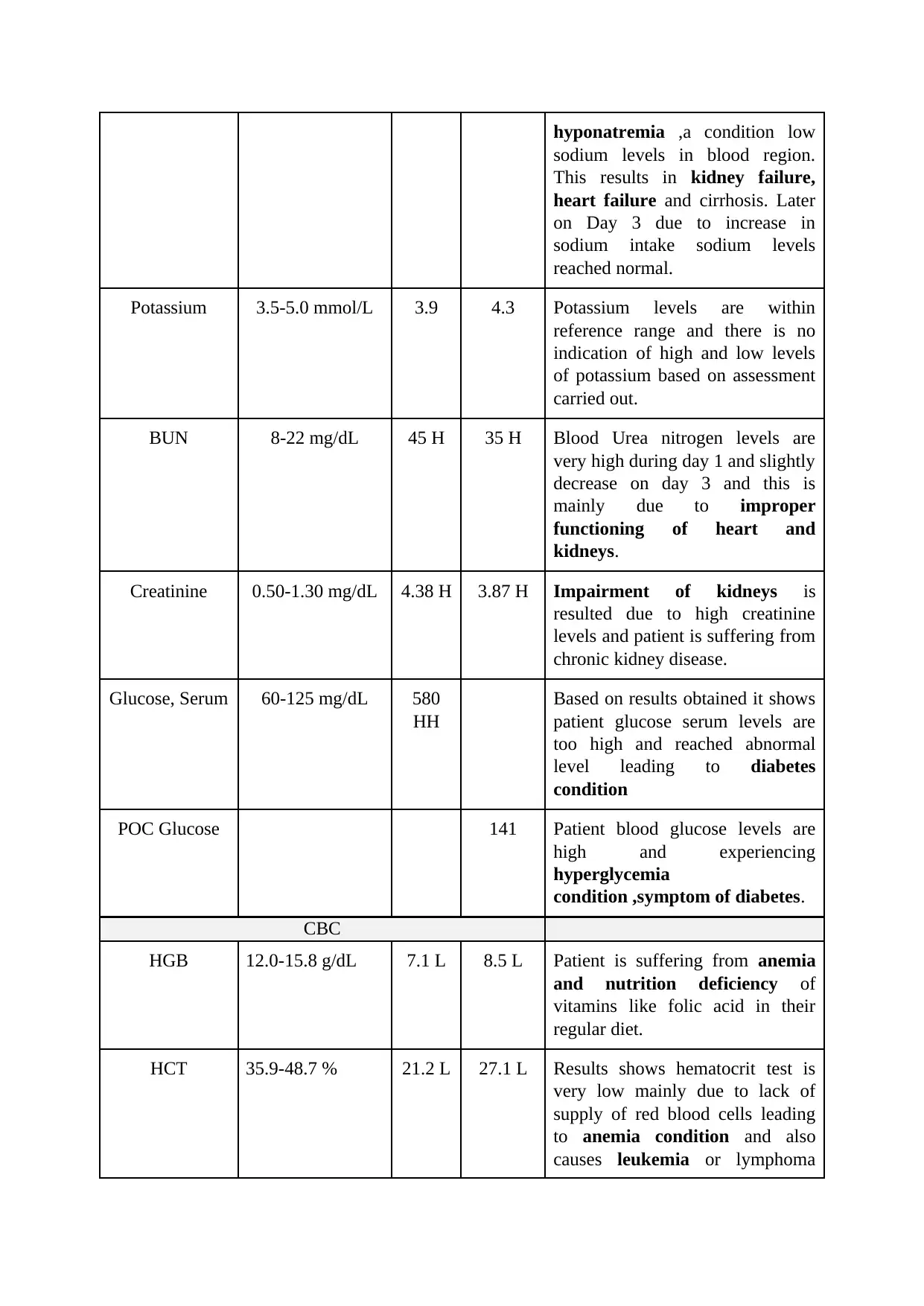
hyponatremia ,a condition low
sodium levels in blood region.
This results in kidney failure,
heart failure and cirrhosis. Later
on Day 3 due to increase in
sodium intake sodium levels
reached normal.
Potassium 3.5-5.0 mmol/L 3.9 4.3 Potassium levels are within
reference range and there is no
indication of high and low levels
of potassium based on assessment
carried out.
BUN 8-22 mg/dL 45 H 35 H Blood Urea nitrogen levels are
very high during day 1 and slightly
decrease on day 3 and this is
mainly due to improper
functioning of heart and
kidneys.
Creatinine 0.50-1.30 mg/dL 4.38 H 3.87 H Impairment of kidneys is
resulted due to high creatinine
levels and patient is suffering from
chronic kidney disease.
Glucose, Serum 60-125 mg/dL 580
HH
Based on results obtained it shows
patient glucose serum levels are
too high and reached abnormal
level leading to diabetes
condition
POC Glucose 141 Patient blood glucose levels are
high and experiencing
hyperglycemia
condition ,symptom of diabetes.
CBC
HGB 12.0-15.8 g/dL 7.1 L 8.5 L Patient is suffering from anemia
and nutrition deficiency of
vitamins like folic acid in their
regular diet.
HCT 35.9-48.7 % 21.2 L 27.1 L Results shows hematocrit test is
very low mainly due to lack of
supply of red blood cells leading
to anemia condition and also
causes leukemia or lymphoma
sodium levels in blood region.
This results in kidney failure,
heart failure and cirrhosis. Later
on Day 3 due to increase in
sodium intake sodium levels
reached normal.
Potassium 3.5-5.0 mmol/L 3.9 4.3 Potassium levels are within
reference range and there is no
indication of high and low levels
of potassium based on assessment
carried out.
BUN 8-22 mg/dL 45 H 35 H Blood Urea nitrogen levels are
very high during day 1 and slightly
decrease on day 3 and this is
mainly due to improper
functioning of heart and
kidneys.
Creatinine 0.50-1.30 mg/dL 4.38 H 3.87 H Impairment of kidneys is
resulted due to high creatinine
levels and patient is suffering from
chronic kidney disease.
Glucose, Serum 60-125 mg/dL 580
HH
Based on results obtained it shows
patient glucose serum levels are
too high and reached abnormal
level leading to diabetes
condition
POC Glucose 141 Patient blood glucose levels are
high and experiencing
hyperglycemia
condition ,symptom of diabetes.
CBC
HGB 12.0-15.8 g/dL 7.1 L 8.5 L Patient is suffering from anemia
and nutrition deficiency of
vitamins like folic acid in their
regular diet.
HCT 35.9-48.7 % 21.2 L 27.1 L Results shows hematocrit test is
very low mainly due to lack of
supply of red blood cells leading
to anemia condition and also
causes leukemia or lymphoma
⊘ This is a preview!⊘
Do you want full access?
Subscribe today to unlock all pages.

Trusted by 1+ million students worldwide
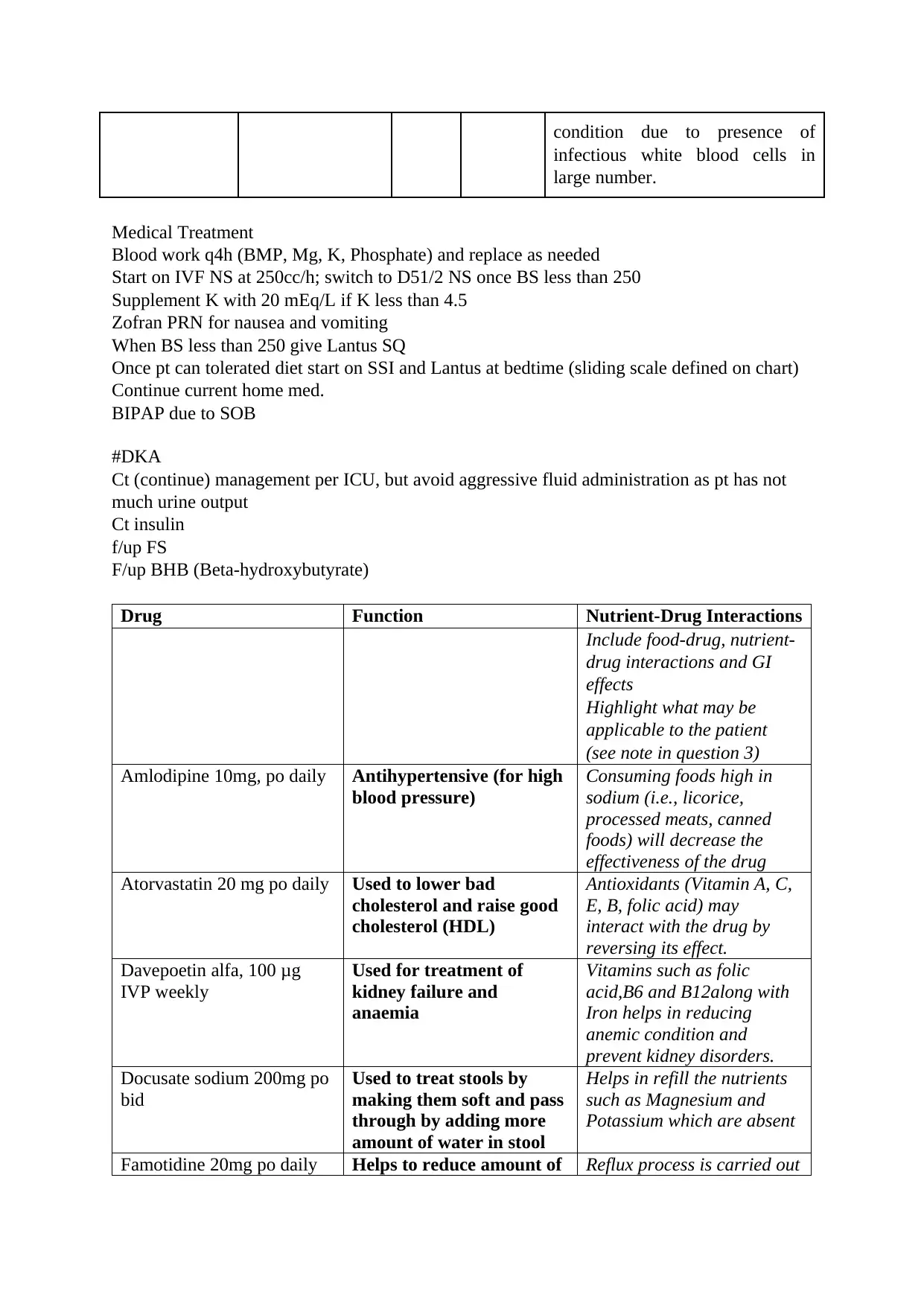
condition due to presence of
infectious white blood cells in
large number.
Medical Treatment
Blood work q4h (BMP, Mg, K, Phosphate) and replace as needed
Start on IVF NS at 250cc/h; switch to D51/2 NS once BS less than 250
Supplement K with 20 mEq/L if K less than 4.5
Zofran PRN for nausea and vomiting
When BS less than 250 give Lantus SQ
Once pt can tolerated diet start on SSI and Lantus at bedtime (sliding scale defined on chart)
Continue current home med.
BIPAP due to SOB
#DKA
Ct (continue) management per ICU, but avoid aggressive fluid administration as pt has not
much urine output
Ct insulin
f/up FS
F/up BHB (Beta-hydroxybutyrate)
Drug Function Nutrient-Drug Interactions
Include food-drug, nutrient-
drug interactions and GI
effects
Highlight what may be
applicable to the patient
(see note in question 3)
Amlodipine 10mg, po daily Antihypertensive (for high
blood pressure)
Consuming foods high in
sodium (i.e., licorice,
processed meats, canned
foods) will decrease the
effectiveness of the drug
Atorvastatin 20 mg po daily Used to lower bad
cholesterol and raise good
cholesterol (HDL)
Antioxidants (Vitamin A, C,
E, B, folic acid) may
interact with the drug by
reversing its effect.
Davepoetin alfa, 100 μg
IVP weekly
Used for treatment of
kidney failure and
anaemia
Vitamins such as folic
acid,B6 and B12along with
Iron helps in reducing
anemic condition and
prevent kidney disorders.
Docusate sodium 200mg po
bid
Used to treat stools by
making them soft and pass
through by adding more
amount of water in stool
Helps in refill the nutrients
such as Magnesium and
Potassium which are absent
Famotidine 20mg po daily Helps to reduce amount of Reflux process is carried out
infectious white blood cells in
large number.
Medical Treatment
Blood work q4h (BMP, Mg, K, Phosphate) and replace as needed
Start on IVF NS at 250cc/h; switch to D51/2 NS once BS less than 250
Supplement K with 20 mEq/L if K less than 4.5
Zofran PRN for nausea and vomiting
When BS less than 250 give Lantus SQ
Once pt can tolerated diet start on SSI and Lantus at bedtime (sliding scale defined on chart)
Continue current home med.
BIPAP due to SOB
#DKA
Ct (continue) management per ICU, but avoid aggressive fluid administration as pt has not
much urine output
Ct insulin
f/up FS
F/up BHB (Beta-hydroxybutyrate)
Drug Function Nutrient-Drug Interactions
Include food-drug, nutrient-
drug interactions and GI
effects
Highlight what may be
applicable to the patient
(see note in question 3)
Amlodipine 10mg, po daily Antihypertensive (for high
blood pressure)
Consuming foods high in
sodium (i.e., licorice,
processed meats, canned
foods) will decrease the
effectiveness of the drug
Atorvastatin 20 mg po daily Used to lower bad
cholesterol and raise good
cholesterol (HDL)
Antioxidants (Vitamin A, C,
E, B, folic acid) may
interact with the drug by
reversing its effect.
Davepoetin alfa, 100 μg
IVP weekly
Used for treatment of
kidney failure and
anaemia
Vitamins such as folic
acid,B6 and B12along with
Iron helps in reducing
anemic condition and
prevent kidney disorders.
Docusate sodium 200mg po
bid
Used to treat stools by
making them soft and pass
through by adding more
amount of water in stool
Helps in refill the nutrients
such as Magnesium and
Potassium which are absent
Famotidine 20mg po daily Helps to reduce amount of Reflux process is carried out
Paraphrase This Document
Need a fresh take? Get an instant paraphrase of this document with our AI Paraphraser
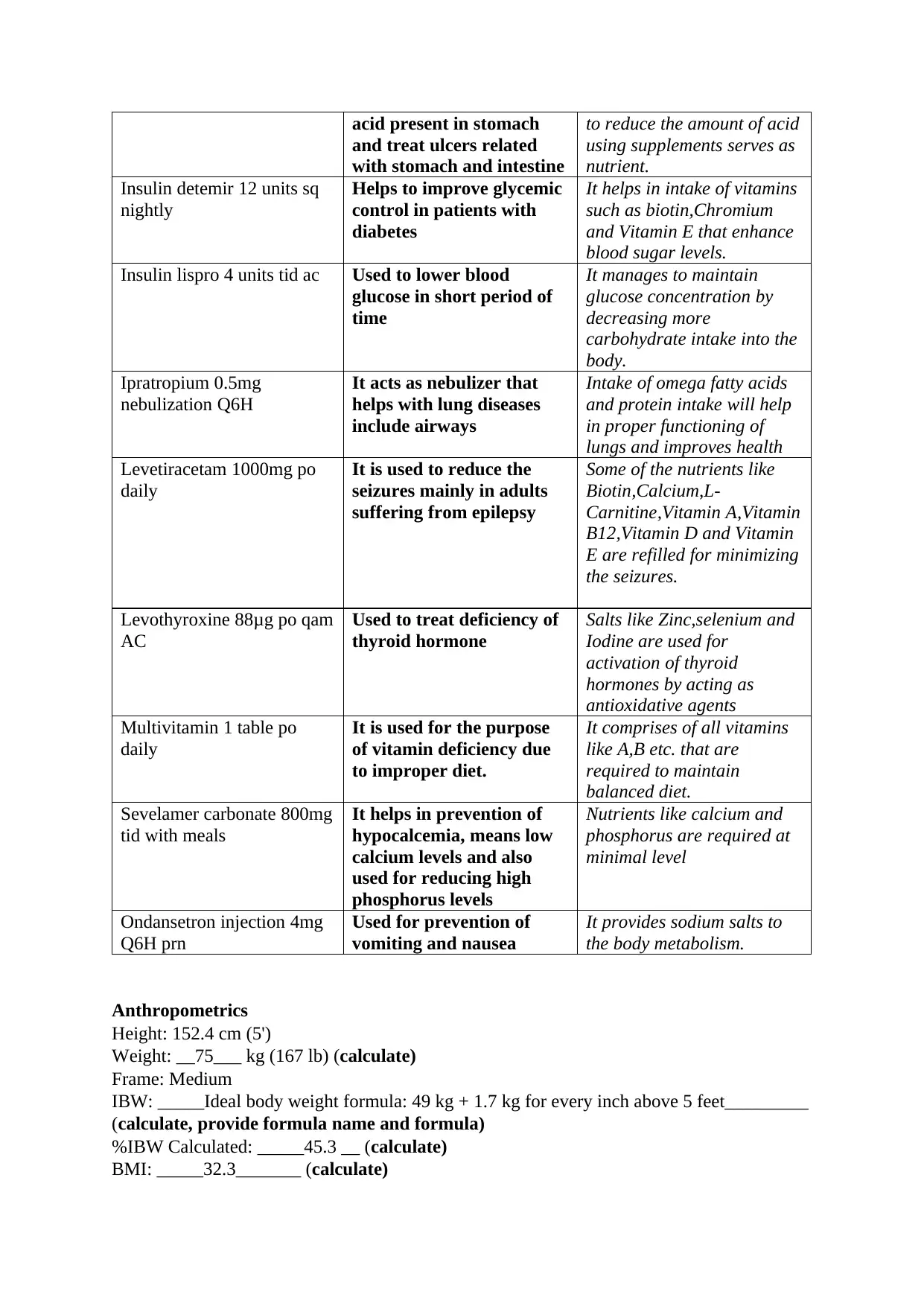
acid present in stomach
and treat ulcers related
with stomach and intestine
to reduce the amount of acid
using supplements serves as
nutrient.
Insulin detemir 12 units sq
nightly
Helps to improve glycemic
control in patients with
diabetes
It helps in intake of vitamins
such as biotin,Chromium
and Vitamin E that enhance
blood sugar levels.
Insulin lispro 4 units tid ac Used to lower blood
glucose in short period of
time
It manages to maintain
glucose concentration by
decreasing more
carbohydrate intake into the
body.
Ipratropium 0.5mg
nebulization Q6H
It acts as nebulizer that
helps with lung diseases
include airways
Intake of omega fatty acids
and protein intake will help
in proper functioning of
lungs and improves health
Levetiracetam 1000mg po
daily
It is used to reduce the
seizures mainly in adults
suffering from epilepsy
Some of the nutrients like
Biotin,Calcium,L-
Carnitine,Vitamin A,Vitamin
B12,Vitamin D and Vitamin
E are refilled for minimizing
the seizures.
Levothyroxine 88μg po qam
AC
Used to treat deficiency of
thyroid hormone
Salts like Zinc,selenium and
Iodine are used for
activation of thyroid
hormones by acting as
antioxidative agents
Multivitamin 1 table po
daily
It is used for the purpose
of vitamin deficiency due
to improper diet.
It comprises of all vitamins
like A,B etc. that are
required to maintain
balanced diet.
Sevelamer carbonate 800mg
tid with meals
It helps in prevention of
hypocalcemia, means low
calcium levels and also
used for reducing high
phosphorus levels
Nutrients like calcium and
phosphorus are required at
minimal level
Ondansetron injection 4mg
Q6H prn
Used for prevention of
vomiting and nausea
It provides sodium salts to
the body metabolism.
Anthropometrics
Height: 152.4 cm (5')
Weight: __75___ kg (167 lb) (calculate)
Frame: Medium
IBW: _____Ideal body weight formula: 49 kg + 1.7 kg for every inch above 5 feet_________
(calculate, provide formula name and formula)
%IBW Calculated: _____45.3 __ (calculate)
BMI: _____32.3_______ (calculate)
and treat ulcers related
with stomach and intestine
to reduce the amount of acid
using supplements serves as
nutrient.
Insulin detemir 12 units sq
nightly
Helps to improve glycemic
control in patients with
diabetes
It helps in intake of vitamins
such as biotin,Chromium
and Vitamin E that enhance
blood sugar levels.
Insulin lispro 4 units tid ac Used to lower blood
glucose in short period of
time
It manages to maintain
glucose concentration by
decreasing more
carbohydrate intake into the
body.
Ipratropium 0.5mg
nebulization Q6H
It acts as nebulizer that
helps with lung diseases
include airways
Intake of omega fatty acids
and protein intake will help
in proper functioning of
lungs and improves health
Levetiracetam 1000mg po
daily
It is used to reduce the
seizures mainly in adults
suffering from epilepsy
Some of the nutrients like
Biotin,Calcium,L-
Carnitine,Vitamin A,Vitamin
B12,Vitamin D and Vitamin
E are refilled for minimizing
the seizures.
Levothyroxine 88μg po qam
AC
Used to treat deficiency of
thyroid hormone
Salts like Zinc,selenium and
Iodine are used for
activation of thyroid
hormones by acting as
antioxidative agents
Multivitamin 1 table po
daily
It is used for the purpose
of vitamin deficiency due
to improper diet.
It comprises of all vitamins
like A,B etc. that are
required to maintain
balanced diet.
Sevelamer carbonate 800mg
tid with meals
It helps in prevention of
hypocalcemia, means low
calcium levels and also
used for reducing high
phosphorus levels
Nutrients like calcium and
phosphorus are required at
minimal level
Ondansetron injection 4mg
Q6H prn
Used for prevention of
vomiting and nausea
It provides sodium salts to
the body metabolism.
Anthropometrics
Height: 152.4 cm (5')
Weight: __75___ kg (167 lb) (calculate)
Frame: Medium
IBW: _____Ideal body weight formula: 49 kg + 1.7 kg for every inch above 5 feet_________
(calculate, provide formula name and formula)
%IBW Calculated: _____45.3 __ (calculate)
BMI: _____32.3_______ (calculate)
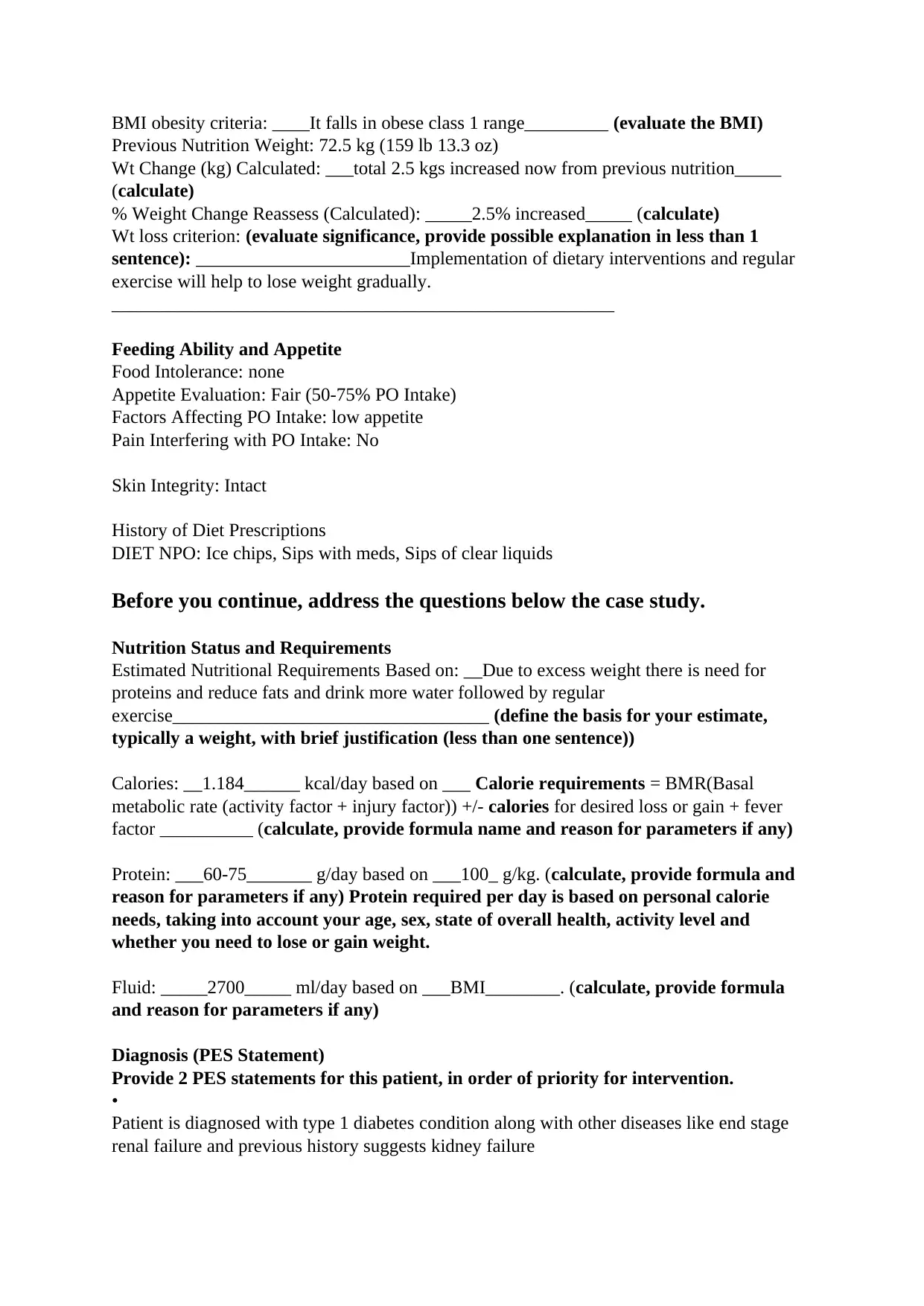
BMI obesity criteria: ____It falls in obese class 1 range_________ (evaluate the BMI)
Previous Nutrition Weight: 72.5 kg (159 lb 13.3 oz)
Wt Change (kg) Calculated: ___total 2.5 kgs increased now from previous nutrition_____
(calculate)
% Weight Change Reassess (Calculated): _____2.5% increased_____ (calculate)
Wt loss criterion: (evaluate significance, provide possible explanation in less than 1
sentence): _______________________Implementation of dietary interventions and regular
exercise will help to lose weight gradually.
______________________________________________________
Feeding Ability and Appetite
Food Intolerance: none
Appetite Evaluation: Fair (50-75% PO Intake)
Factors Affecting PO Intake: low appetite
Pain Interfering with PO Intake: No
Skin Integrity: Intact
History of Diet Prescriptions
DIET NPO: Ice chips, Sips with meds, Sips of clear liquids
Before you continue, address the questions below the case study.
Nutrition Status and Requirements
Estimated Nutritional Requirements Based on: __Due to excess weight there is need for
proteins and reduce fats and drink more water followed by regular
exercise__________________________________ (define the basis for your estimate,
typically a weight, with brief justification (less than one sentence))
Calories: __1.184______ kcal/day based on ___ Calorie requirements = BMR(Basal
metabolic rate (activity factor + injury factor)) +/- calories for desired loss or gain + fever
factor __________ (calculate, provide formula name and reason for parameters if any)
Protein: ___60-75_______ g/day based on ___100_ g/kg. (calculate, provide formula and
reason for parameters if any) Protein required per day is based on personal calorie
needs, taking into account your age, sex, state of overall health, activity level and
whether you need to lose or gain weight.
Fluid: _____2700_____ ml/day based on ___BMI________. (calculate, provide formula
and reason for parameters if any)
Diagnosis (PES Statement)
Provide 2 PES statements for this patient, in order of priority for intervention.
•
Patient is diagnosed with type 1 diabetes condition along with other diseases like end stage
renal failure and previous history suggests kidney failure
Previous Nutrition Weight: 72.5 kg (159 lb 13.3 oz)
Wt Change (kg) Calculated: ___total 2.5 kgs increased now from previous nutrition_____
(calculate)
% Weight Change Reassess (Calculated): _____2.5% increased_____ (calculate)
Wt loss criterion: (evaluate significance, provide possible explanation in less than 1
sentence): _______________________Implementation of dietary interventions and regular
exercise will help to lose weight gradually.
______________________________________________________
Feeding Ability and Appetite
Food Intolerance: none
Appetite Evaluation: Fair (50-75% PO Intake)
Factors Affecting PO Intake: low appetite
Pain Interfering with PO Intake: No
Skin Integrity: Intact
History of Diet Prescriptions
DIET NPO: Ice chips, Sips with meds, Sips of clear liquids
Before you continue, address the questions below the case study.
Nutrition Status and Requirements
Estimated Nutritional Requirements Based on: __Due to excess weight there is need for
proteins and reduce fats and drink more water followed by regular
exercise__________________________________ (define the basis for your estimate,
typically a weight, with brief justification (less than one sentence))
Calories: __1.184______ kcal/day based on ___ Calorie requirements = BMR(Basal
metabolic rate (activity factor + injury factor)) +/- calories for desired loss or gain + fever
factor __________ (calculate, provide formula name and reason for parameters if any)
Protein: ___60-75_______ g/day based on ___100_ g/kg. (calculate, provide formula and
reason for parameters if any) Protein required per day is based on personal calorie
needs, taking into account your age, sex, state of overall health, activity level and
whether you need to lose or gain weight.
Fluid: _____2700_____ ml/day based on ___BMI________. (calculate, provide formula
and reason for parameters if any)
Diagnosis (PES Statement)
Provide 2 PES statements for this patient, in order of priority for intervention.
•
Patient is diagnosed with type 1 diabetes condition along with other diseases like end stage
renal failure and previous history suggests kidney failure
⊘ This is a preview!⊘
Do you want full access?
Subscribe today to unlock all pages.

Trusted by 1+ million students worldwide
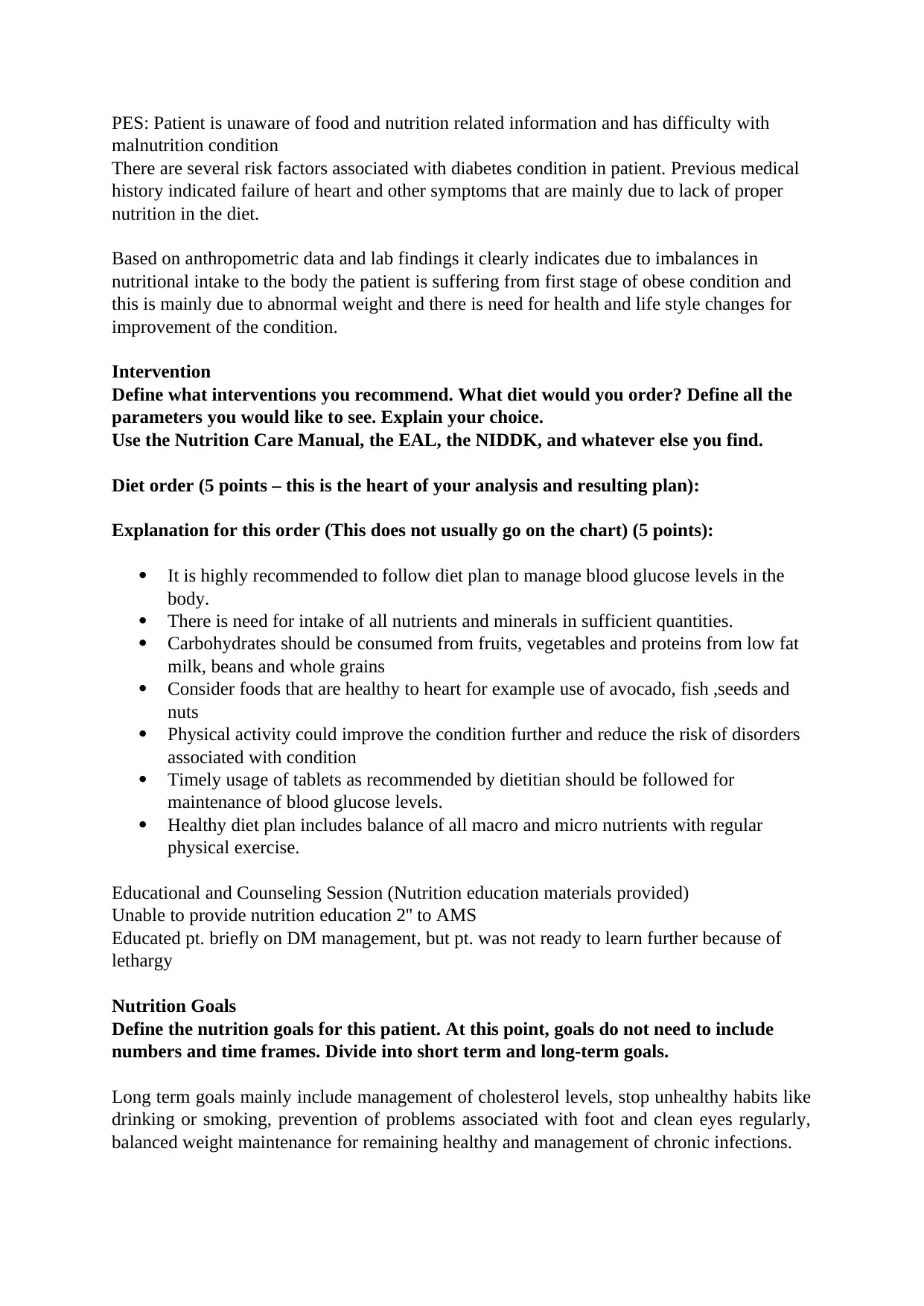
PES: Patient is unaware of food and nutrition related information and has difficulty with
malnutrition condition
There are several risk factors associated with diabetes condition in patient. Previous medical
history indicated failure of heart and other symptoms that are mainly due to lack of proper
nutrition in the diet.
Based on anthropometric data and lab findings it clearly indicates due to imbalances in
nutritional intake to the body the patient is suffering from first stage of obese condition and
this is mainly due to abnormal weight and there is need for health and life style changes for
improvement of the condition.
Intervention
Define what interventions you recommend. What diet would you order? Define all the
parameters you would like to see. Explain your choice.
Use the Nutrition Care Manual, the EAL, the NIDDK, and whatever else you find.
Diet order (5 points – this is the heart of your analysis and resulting plan):
Explanation for this order (This does not usually go on the chart) (5 points):
It is highly recommended to follow diet plan to manage blood glucose levels in the
body.
There is need for intake of all nutrients and minerals in sufficient quantities.
Carbohydrates should be consumed from fruits, vegetables and proteins from low fat
milk, beans and whole grains
Consider foods that are healthy to heart for example use of avocado, fish ,seeds and
nuts
Physical activity could improve the condition further and reduce the risk of disorders
associated with condition
Timely usage of tablets as recommended by dietitian should be followed for
maintenance of blood glucose levels.
Healthy diet plan includes balance of all macro and micro nutrients with regular
physical exercise.
Educational and Counseling Session (Nutrition education materials provided)
Unable to provide nutrition education 2'' to AMS
Educated pt. briefly on DM management, but pt. was not ready to learn further because of
lethargy
Nutrition Goals
Define the nutrition goals for this patient. At this point, goals do not need to include
numbers and time frames. Divide into short term and long-term goals.
Long term goals mainly include management of cholesterol levels, stop unhealthy habits like
drinking or smoking, prevention of problems associated with foot and clean eyes regularly,
balanced weight maintenance for remaining healthy and management of chronic infections.
malnutrition condition
There are several risk factors associated with diabetes condition in patient. Previous medical
history indicated failure of heart and other symptoms that are mainly due to lack of proper
nutrition in the diet.
Based on anthropometric data and lab findings it clearly indicates due to imbalances in
nutritional intake to the body the patient is suffering from first stage of obese condition and
this is mainly due to abnormal weight and there is need for health and life style changes for
improvement of the condition.
Intervention
Define what interventions you recommend. What diet would you order? Define all the
parameters you would like to see. Explain your choice.
Use the Nutrition Care Manual, the EAL, the NIDDK, and whatever else you find.
Diet order (5 points – this is the heart of your analysis and resulting plan):
Explanation for this order (This does not usually go on the chart) (5 points):
It is highly recommended to follow diet plan to manage blood glucose levels in the
body.
There is need for intake of all nutrients and minerals in sufficient quantities.
Carbohydrates should be consumed from fruits, vegetables and proteins from low fat
milk, beans and whole grains
Consider foods that are healthy to heart for example use of avocado, fish ,seeds and
nuts
Physical activity could improve the condition further and reduce the risk of disorders
associated with condition
Timely usage of tablets as recommended by dietitian should be followed for
maintenance of blood glucose levels.
Healthy diet plan includes balance of all macro and micro nutrients with regular
physical exercise.
Educational and Counseling Session (Nutrition education materials provided)
Unable to provide nutrition education 2'' to AMS
Educated pt. briefly on DM management, but pt. was not ready to learn further because of
lethargy
Nutrition Goals
Define the nutrition goals for this patient. At this point, goals do not need to include
numbers and time frames. Divide into short term and long-term goals.
Long term goals mainly include management of cholesterol levels, stop unhealthy habits like
drinking or smoking, prevention of problems associated with foot and clean eyes regularly,
balanced weight maintenance for remaining healthy and management of chronic infections.
Paraphrase This Document
Need a fresh take? Get an instant paraphrase of this document with our AI Paraphraser
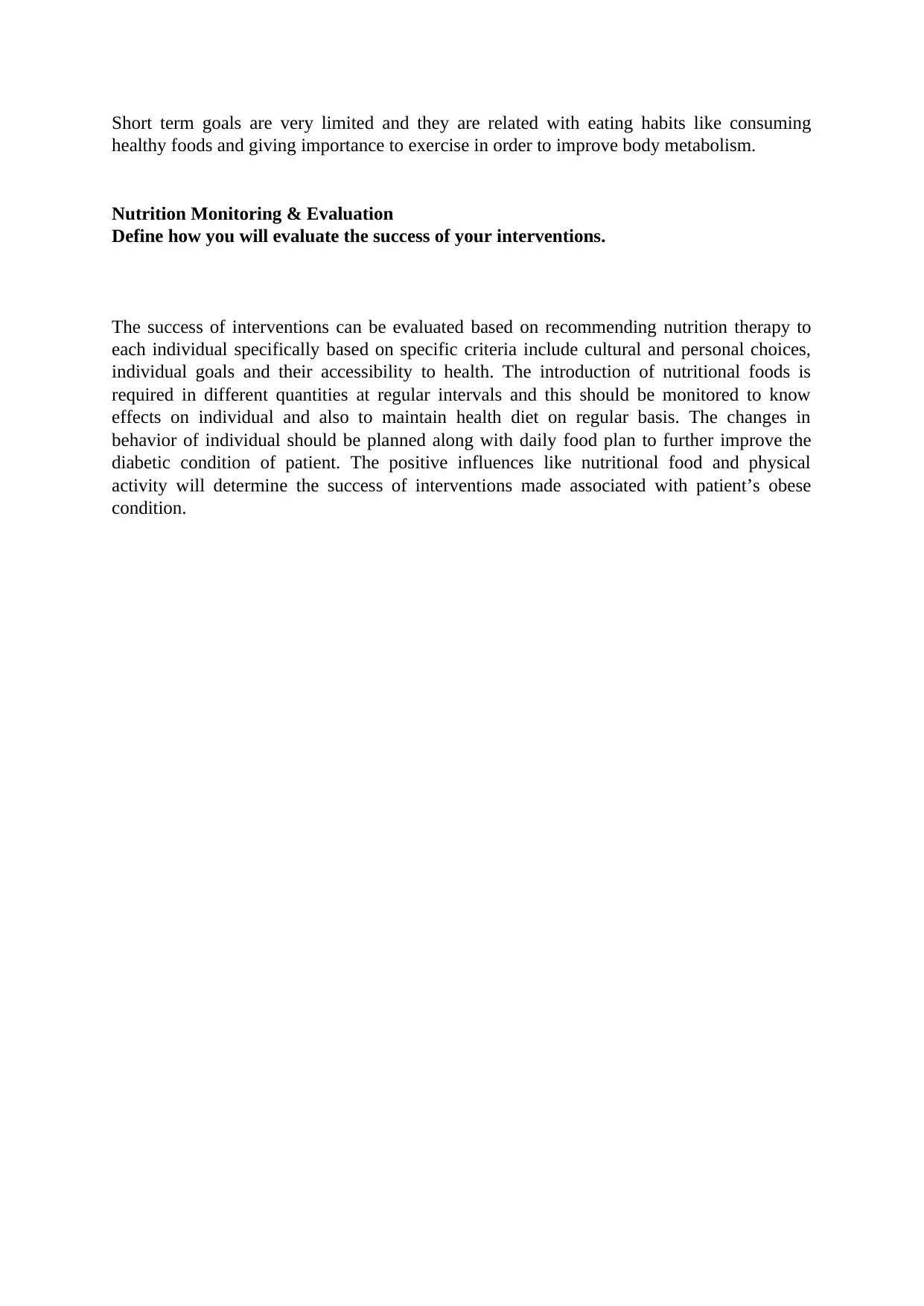
Short term goals are very limited and they are related with eating habits like consuming
healthy foods and giving importance to exercise in order to improve body metabolism.
Nutrition Monitoring & Evaluation
Define how you will evaluate the success of your interventions.
The success of interventions can be evaluated based on recommending nutrition therapy to
each individual specifically based on specific criteria include cultural and personal choices,
individual goals and their accessibility to health. The introduction of nutritional foods is
required in different quantities at regular intervals and this should be monitored to know
effects on individual and also to maintain health diet on regular basis. The changes in
behavior of individual should be planned along with daily food plan to further improve the
diabetic condition of patient. The positive influences like nutritional food and physical
activity will determine the success of interventions made associated with patient’s obese
condition.
healthy foods and giving importance to exercise in order to improve body metabolism.
Nutrition Monitoring & Evaluation
Define how you will evaluate the success of your interventions.
The success of interventions can be evaluated based on recommending nutrition therapy to
each individual specifically based on specific criteria include cultural and personal choices,
individual goals and their accessibility to health. The introduction of nutritional foods is
required in different quantities at regular intervals and this should be monitored to know
effects on individual and also to maintain health diet on regular basis. The changes in
behavior of individual should be planned along with daily food plan to further improve the
diabetic condition of patient. The positive influences like nutritional food and physical
activity will determine the success of interventions made associated with patient’s obese
condition.
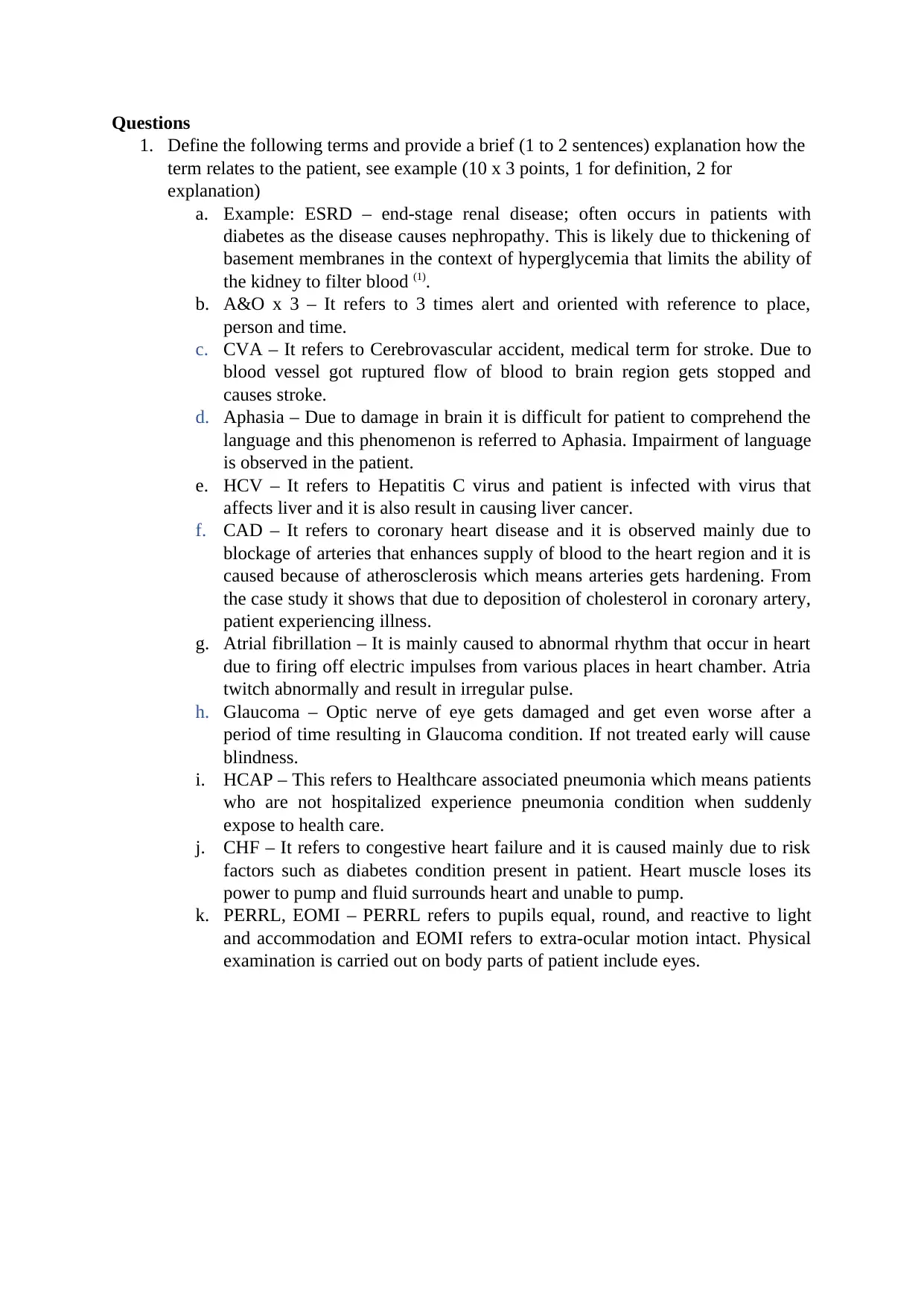
Questions
1. Define the following terms and provide a brief (1 to 2 sentences) explanation how the
term relates to the patient, see example (10 x 3 points, 1 for definition, 2 for
explanation)
a. Example: ESRD – end-stage renal disease; often occurs in patients with
diabetes as the disease causes nephropathy. This is likely due to thickening of
basement membranes in the context of hyperglycemia that limits the ability of
the kidney to filter blood (1).
b. A&O x 3 – It refers to 3 times alert and oriented with reference to place,
person and time.
c. CVA – It refers to Cerebrovascular accident, medical term for stroke. Due to
blood vessel got ruptured flow of blood to brain region gets stopped and
causes stroke.
d. Aphasia – Due to damage in brain it is difficult for patient to comprehend the
language and this phenomenon is referred to Aphasia. Impairment of language
is observed in the patient.
e. HCV – It refers to Hepatitis C virus and patient is infected with virus that
affects liver and it is also result in causing liver cancer.
f. CAD – It refers to coronary heart disease and it is observed mainly due to
blockage of arteries that enhances supply of blood to the heart region and it is
caused because of atherosclerosis which means arteries gets hardening. From
the case study it shows that due to deposition of cholesterol in coronary artery,
patient experiencing illness.
g. Atrial fibrillation – It is mainly caused to abnormal rhythm that occur in heart
due to firing off electric impulses from various places in heart chamber. Atria
twitch abnormally and result in irregular pulse.
h. Glaucoma – Optic nerve of eye gets damaged and get even worse after a
period of time resulting in Glaucoma condition. If not treated early will cause
blindness.
i. HCAP – This refers to Healthcare associated pneumonia which means patients
who are not hospitalized experience pneumonia condition when suddenly
expose to health care.
j. CHF – It refers to congestive heart failure and it is caused mainly due to risk
factors such as diabetes condition present in patient. Heart muscle loses its
power to pump and fluid surrounds heart and unable to pump.
k. PERRL, EOMI – PERRL refers to pupils equal, round, and reactive to light
and accommodation and EOMI refers to extra-ocular motion intact. Physical
examination is carried out on body parts of patient include eyes.
1. Define the following terms and provide a brief (1 to 2 sentences) explanation how the
term relates to the patient, see example (10 x 3 points, 1 for definition, 2 for
explanation)
a. Example: ESRD – end-stage renal disease; often occurs in patients with
diabetes as the disease causes nephropathy. This is likely due to thickening of
basement membranes in the context of hyperglycemia that limits the ability of
the kidney to filter blood (1).
b. A&O x 3 – It refers to 3 times alert and oriented with reference to place,
person and time.
c. CVA – It refers to Cerebrovascular accident, medical term for stroke. Due to
blood vessel got ruptured flow of blood to brain region gets stopped and
causes stroke.
d. Aphasia – Due to damage in brain it is difficult for patient to comprehend the
language and this phenomenon is referred to Aphasia. Impairment of language
is observed in the patient.
e. HCV – It refers to Hepatitis C virus and patient is infected with virus that
affects liver and it is also result in causing liver cancer.
f. CAD – It refers to coronary heart disease and it is observed mainly due to
blockage of arteries that enhances supply of blood to the heart region and it is
caused because of atherosclerosis which means arteries gets hardening. From
the case study it shows that due to deposition of cholesterol in coronary artery,
patient experiencing illness.
g. Atrial fibrillation – It is mainly caused to abnormal rhythm that occur in heart
due to firing off electric impulses from various places in heart chamber. Atria
twitch abnormally and result in irregular pulse.
h. Glaucoma – Optic nerve of eye gets damaged and get even worse after a
period of time resulting in Glaucoma condition. If not treated early will cause
blindness.
i. HCAP – This refers to Healthcare associated pneumonia which means patients
who are not hospitalized experience pneumonia condition when suddenly
expose to health care.
j. CHF – It refers to congestive heart failure and it is caused mainly due to risk
factors such as diabetes condition present in patient. Heart muscle loses its
power to pump and fluid surrounds heart and unable to pump.
k. PERRL, EOMI – PERRL refers to pupils equal, round, and reactive to light
and accommodation and EOMI refers to extra-ocular motion intact. Physical
examination is carried out on body parts of patient include eyes.
⊘ This is a preview!⊘
Do you want full access?
Subscribe today to unlock all pages.

Trusted by 1+ million students worldwide
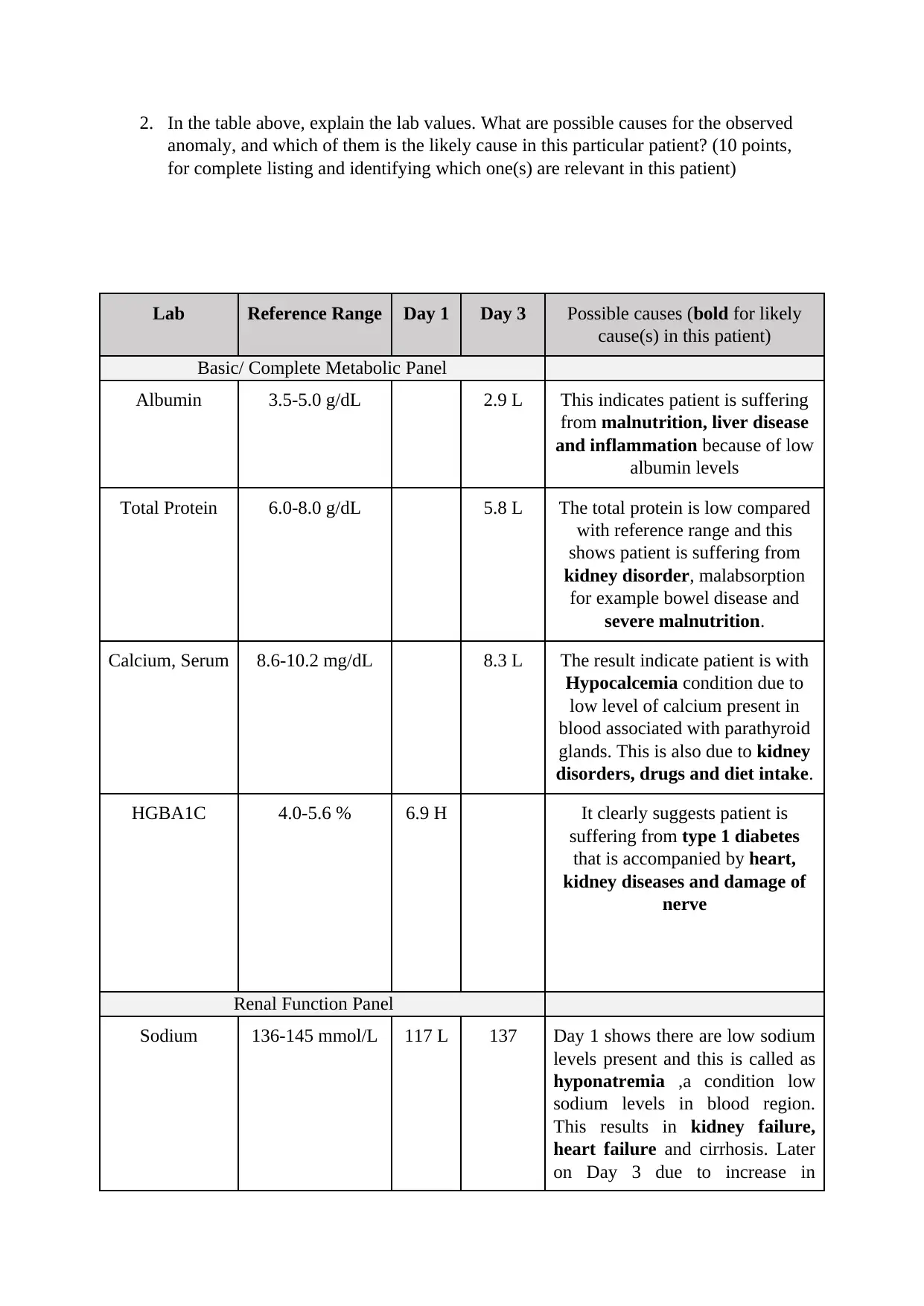
2. In the table above, explain the lab values. What are possible causes for the observed
anomaly, and which of them is the likely cause in this particular patient? (10 points,
for complete listing and identifying which one(s) are relevant in this patient)
Lab Reference Range Day 1 Day 3 Possible causes (bold for likely
cause(s) in this patient)
Basic/ Complete Metabolic Panel
Albumin 3.5-5.0 g/dL 2.9 L This indicates patient is suffering
from malnutrition, liver disease
and inflammation because of low
albumin levels
Total Protein 6.0-8.0 g/dL 5.8 L The total protein is low compared
with reference range and this
shows patient is suffering from
kidney disorder, malabsorption
for example bowel disease and
severe malnutrition.
Calcium, Serum 8.6-10.2 mg/dL 8.3 L The result indicate patient is with
Hypocalcemia condition due to
low level of calcium present in
blood associated with parathyroid
glands. This is also due to kidney
disorders, drugs and diet intake.
HGBA1C 4.0-5.6 % 6.9 H It clearly suggests patient is
suffering from type 1 diabetes
that is accompanied by heart,
kidney diseases and damage of
nerve
Renal Function Panel
Sodium 136-145 mmol/L 117 L 137 Day 1 shows there are low sodium
levels present and this is called as
hyponatremia ,a condition low
sodium levels in blood region.
This results in kidney failure,
heart failure and cirrhosis. Later
on Day 3 due to increase in
anomaly, and which of them is the likely cause in this particular patient? (10 points,
for complete listing and identifying which one(s) are relevant in this patient)
Lab Reference Range Day 1 Day 3 Possible causes (bold for likely
cause(s) in this patient)
Basic/ Complete Metabolic Panel
Albumin 3.5-5.0 g/dL 2.9 L This indicates patient is suffering
from malnutrition, liver disease
and inflammation because of low
albumin levels
Total Protein 6.0-8.0 g/dL 5.8 L The total protein is low compared
with reference range and this
shows patient is suffering from
kidney disorder, malabsorption
for example bowel disease and
severe malnutrition.
Calcium, Serum 8.6-10.2 mg/dL 8.3 L The result indicate patient is with
Hypocalcemia condition due to
low level of calcium present in
blood associated with parathyroid
glands. This is also due to kidney
disorders, drugs and diet intake.
HGBA1C 4.0-5.6 % 6.9 H It clearly suggests patient is
suffering from type 1 diabetes
that is accompanied by heart,
kidney diseases and damage of
nerve
Renal Function Panel
Sodium 136-145 mmol/L 117 L 137 Day 1 shows there are low sodium
levels present and this is called as
hyponatremia ,a condition low
sodium levels in blood region.
This results in kidney failure,
heart failure and cirrhosis. Later
on Day 3 due to increase in
Paraphrase This Document
Need a fresh take? Get an instant paraphrase of this document with our AI Paraphraser
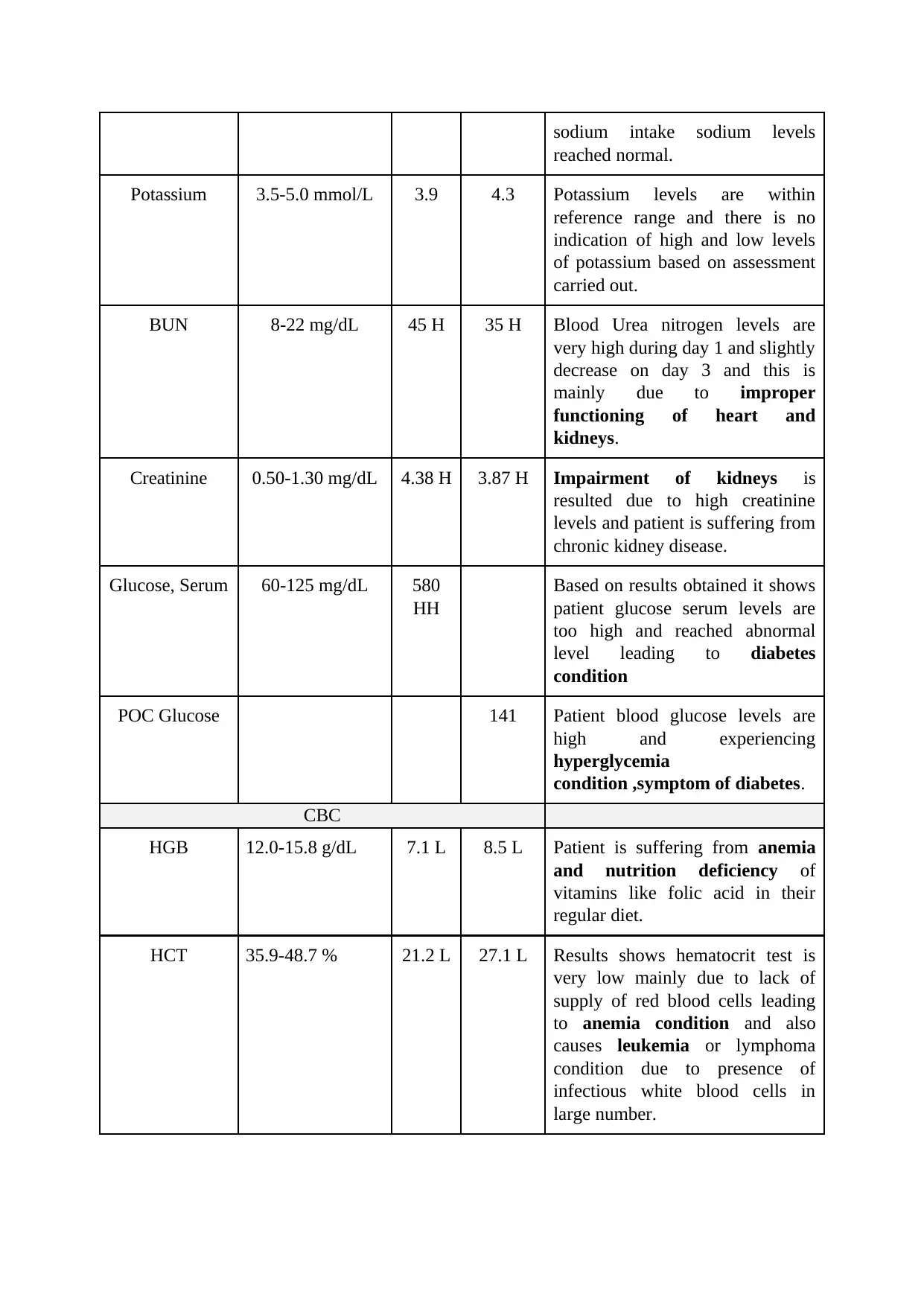
sodium intake sodium levels
reached normal.
Potassium 3.5-5.0 mmol/L 3.9 4.3 Potassium levels are within
reference range and there is no
indication of high and low levels
of potassium based on assessment
carried out.
BUN 8-22 mg/dL 45 H 35 H Blood Urea nitrogen levels are
very high during day 1 and slightly
decrease on day 3 and this is
mainly due to improper
functioning of heart and
kidneys.
Creatinine 0.50-1.30 mg/dL 4.38 H 3.87 H Impairment of kidneys is
resulted due to high creatinine
levels and patient is suffering from
chronic kidney disease.
Glucose, Serum 60-125 mg/dL 580
HH
Based on results obtained it shows
patient glucose serum levels are
too high and reached abnormal
level leading to diabetes
condition
POC Glucose 141 Patient blood glucose levels are
high and experiencing
hyperglycemia
condition ,symptom of diabetes.
CBC
HGB 12.0-15.8 g/dL 7.1 L 8.5 L Patient is suffering from anemia
and nutrition deficiency of
vitamins like folic acid in their
regular diet.
HCT 35.9-48.7 % 21.2 L 27.1 L Results shows hematocrit test is
very low mainly due to lack of
supply of red blood cells leading
to anemia condition and also
causes leukemia or lymphoma
condition due to presence of
infectious white blood cells in
large number.
reached normal.
Potassium 3.5-5.0 mmol/L 3.9 4.3 Potassium levels are within
reference range and there is no
indication of high and low levels
of potassium based on assessment
carried out.
BUN 8-22 mg/dL 45 H 35 H Blood Urea nitrogen levels are
very high during day 1 and slightly
decrease on day 3 and this is
mainly due to improper
functioning of heart and
kidneys.
Creatinine 0.50-1.30 mg/dL 4.38 H 3.87 H Impairment of kidneys is
resulted due to high creatinine
levels and patient is suffering from
chronic kidney disease.
Glucose, Serum 60-125 mg/dL 580
HH
Based on results obtained it shows
patient glucose serum levels are
too high and reached abnormal
level leading to diabetes
condition
POC Glucose 141 Patient blood glucose levels are
high and experiencing
hyperglycemia
condition ,symptom of diabetes.
CBC
HGB 12.0-15.8 g/dL 7.1 L 8.5 L Patient is suffering from anemia
and nutrition deficiency of
vitamins like folic acid in their
regular diet.
HCT 35.9-48.7 % 21.2 L 27.1 L Results shows hematocrit test is
very low mainly due to lack of
supply of red blood cells leading
to anemia condition and also
causes leukemia or lymphoma
condition due to presence of
infectious white blood cells in
large number.
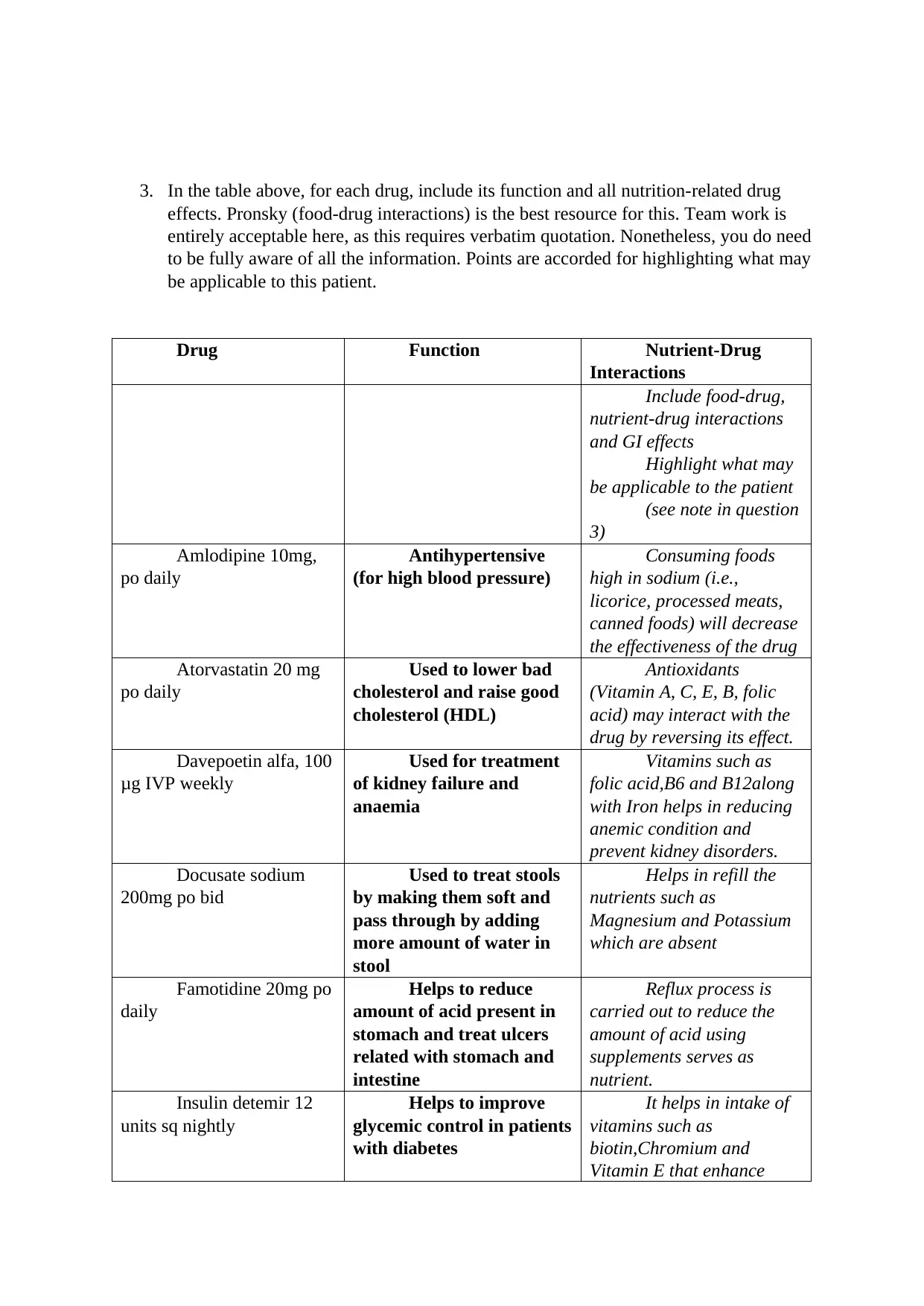
3. In the table above, for each drug, include its function and all nutrition-related drug
effects. Pronsky (food-drug interactions) is the best resource for this. Team work is
entirely acceptable here, as this requires verbatim quotation. Nonetheless, you do need
to be fully aware of all the information. Points are accorded for highlighting what may
be applicable to this patient.
Drug Function Nutrient-Drug
Interactions
Include food-drug,
nutrient-drug interactions
and GI effects
Highlight what may
be applicable to the patient
(see note in question
3)
Amlodipine 10mg,
po daily
Antihypertensive
(for high blood pressure)
Consuming foods
high in sodium (i.e.,
licorice, processed meats,
canned foods) will decrease
the effectiveness of the drug
Atorvastatin 20 mg
po daily
Used to lower bad
cholesterol and raise good
cholesterol (HDL)
Antioxidants
(Vitamin A, C, E, B, folic
acid) may interact with the
drug by reversing its effect.
Davepoetin alfa, 100
μg IVP weekly
Used for treatment
of kidney failure and
anaemia
Vitamins such as
folic acid,B6 and B12along
with Iron helps in reducing
anemic condition and
prevent kidney disorders.
Docusate sodium
200mg po bid
Used to treat stools
by making them soft and
pass through by adding
more amount of water in
stool
Helps in refill the
nutrients such as
Magnesium and Potassium
which are absent
Famotidine 20mg po
daily
Helps to reduce
amount of acid present in
stomach and treat ulcers
related with stomach and
intestine
Reflux process is
carried out to reduce the
amount of acid using
supplements serves as
nutrient.
Insulin detemir 12
units sq nightly
Helps to improve
glycemic control in patients
with diabetes
It helps in intake of
vitamins such as
biotin,Chromium and
Vitamin E that enhance
effects. Pronsky (food-drug interactions) is the best resource for this. Team work is
entirely acceptable here, as this requires verbatim quotation. Nonetheless, you do need
to be fully aware of all the information. Points are accorded for highlighting what may
be applicable to this patient.
Drug Function Nutrient-Drug
Interactions
Include food-drug,
nutrient-drug interactions
and GI effects
Highlight what may
be applicable to the patient
(see note in question
3)
Amlodipine 10mg,
po daily
Antihypertensive
(for high blood pressure)
Consuming foods
high in sodium (i.e.,
licorice, processed meats,
canned foods) will decrease
the effectiveness of the drug
Atorvastatin 20 mg
po daily
Used to lower bad
cholesterol and raise good
cholesterol (HDL)
Antioxidants
(Vitamin A, C, E, B, folic
acid) may interact with the
drug by reversing its effect.
Davepoetin alfa, 100
μg IVP weekly
Used for treatment
of kidney failure and
anaemia
Vitamins such as
folic acid,B6 and B12along
with Iron helps in reducing
anemic condition and
prevent kidney disorders.
Docusate sodium
200mg po bid
Used to treat stools
by making them soft and
pass through by adding
more amount of water in
stool
Helps in refill the
nutrients such as
Magnesium and Potassium
which are absent
Famotidine 20mg po
daily
Helps to reduce
amount of acid present in
stomach and treat ulcers
related with stomach and
intestine
Reflux process is
carried out to reduce the
amount of acid using
supplements serves as
nutrient.
Insulin detemir 12
units sq nightly
Helps to improve
glycemic control in patients
with diabetes
It helps in intake of
vitamins such as
biotin,Chromium and
Vitamin E that enhance
⊘ This is a preview!⊘
Do you want full access?
Subscribe today to unlock all pages.

Trusted by 1+ million students worldwide
1 out of 17
Related Documents
Your All-in-One AI-Powered Toolkit for Academic Success.
+13062052269
info@desklib.com
Available 24*7 on WhatsApp / Email
![[object Object]](/_next/static/media/star-bottom.7253800d.svg)
Unlock your academic potential
Copyright © 2020–2025 A2Z Services. All Rights Reserved. Developed and managed by ZUCOL.



